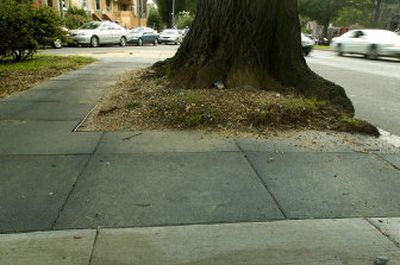Used tires find new life in rubberized sidewalks

WASHINGTON – Pounding the pavement is getting a little easier on people’s knees in many cities around the country.
For reasons of safety and ease of maintenance, Washington and dozens of other communities are installing rubber sidewalks made of ground-up tires.
The rubber squares are up to three times more expensive than concrete slabs but last longer, because tree roots and freezing weather won’t crack them. That, in turn, could reduce the number of slip-and-fall lawsuits filed over uneven pavement.
The shock-absorbing surface also happens to be easier on the joints of joggers, and more forgiving when someone takes a spill.
And the rubber sidewalks are considered more environmentally friendly: They offer a way to recycle some of the estimated 290 million tires thrown out each year in the U.S., and they do not constrict tree roots the way concrete slabs do.
“As our trees grow and mature sometimes the root systems begin to pull up the sidewalks,” said Michelle L. Pourciau, acting director of the D.C. Transportation Department. “This is compromise between having a beautiful and healthy tree and having a safe and passable sidewalk.”
Rubbersidewalks Inc. of Gardena, Calif., manufactures the small rubberized squares now being used on some sidewalks in more than 60 cities, including Washington.
Since 2001, Rubbersidewalks has been grinding thousands of old tires into crumbs, adding chemical binders and baking the material into sidewalk sections that weigh less than 11 pounds per square foot, or a quarter of the weight of concrete. The panels are available in two shades of gray and a terra cotta orange.
Many of the squares have been installed in areas where damage from tree roots, weather and snow removal have required sidewalk replacement or major repairs every three years, said Lindsay Smith, founder and president of Rubbersidewalks. Rubber sidewalks are expected to last seven years or more, Smith said.
The District of Columbia has spent about $60,000 to replace broken concrete with the rubberized panels here and there in a residential neighborhood northeast of the Capitol where towering willow oaks line the street.
The panels are firmer than a running track or a rubberized playground, but far more resilient than concrete.
Dr. Frank Kelly, a member of the American Academy of Orthopaedic Surgeons in Macon, Ga., said people walking on the surface would be less vulnerable to heel spurs and knee and back problems.
In 2004, the sidewalks in front of two homes in New Rochelle, N.Y., were replaced after roots repeatedly caused concrete cracking and heaving. The rubber panels have withstood two winters of snow shoveling, rock salt and repeated freezing and thawing.
About 100 feet of rubber sidewalk was installed in a town square-style shopping area in Tallahassee, Fla., in 2003 as a temporary measure after a major root pruning project.
“They wanted that to be in place for a year before we came back and put the concrete in,” said Tom Lewis, the city’s street maintenance and construction supervisor, “but the rubber has held up so well, we’ve just left it out there.”